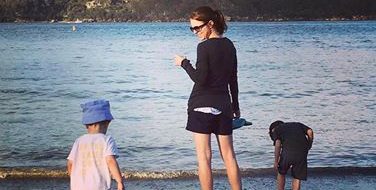I was tagged recently on Facebook in a photo of my first grade class. The first thing I noticed, natch, was myself: a nervous, rule-following, hands-folded six-year-old in a peach dress with a placating, not entirely genuine smile. Then I zoomed out to take in the full picture, and I noticed a couplet of offences: we had two teachers that year, one morning and one afternoon, and the name of the Black afternoon teacher wasn’t listed on the information card held by the students in the front row. Second, there was a…ahem…curious arrangement of students, with all of the Black students relegated to the back row except for two, who were placed on the ends of the other two rows.
Weird, right? I think so. So did a friend, when I texted her the pic and asked if she noticed anything. She spotted it right away.
Thirty-seven years later and these injustices, large and small, are finally catching the attention of people beyond just those upon whom they were targeted. I received a message recently from a high school friend who was letting me know about some accusations that have recently been voiced about blatant acts of racism that occurred there throughout the years, both during our tenure and after, and I thought about how blind I’d been to all of it; how, at the time, I would have found a way to even justify it. I believed that we all came from a level playing field because that’s what I was taught.
It’s a lie.
I was lucky, fortunate, (#)blessed to grow up in a financially secure, two-parent home. The gravest injustice I endured was of the I-only-have-three-Swatches-to-stack-on-my-arm variety. Meanwhile, people around me–children–were treated differently; were, two decades after the Civil Rights Act, told to stand in a different row. This was their day-to-day life. How could I possibly understand that, or see it as a level playing field?
After Little Brother’s soccer game on Saturday, once we were all in the car, I checked my phone and gasped at the news of Chadwick Boseman. The boys asked what had happened and I told them–Black Panther died. And the first thing The Kid said? “Was it COVID or the police that killed him?”
I’m not sharing this as a sad little anecdote to garner white expressions of temporary ruefulness; I find it fucking heartbreaking. I actually have to tell my children that some people don’t like other people simply because of the colour of their skin and then watch my boys’ faces screw up in confusion because they don’t remember the last time they heard something so asinine, so mind-numbingly, God-defyingly stupid. I dread the day I have to admit my own complicity.
I find myself in conversations with friends who grew up similarly to me as far as timing and geography, and we are all coming to terms with the contradictions that ran rampant in our homes and churches. We’re angry. Those of us who aren’t currently in therapy know we need it. We’ve inherited a complicated, messy set of “principles” that is collapsing in on itself.
But we’re doing something about it.
How? In every way, I hope. In the recognition that what is wrong needs to be made right. In admitting that we are often wrong, and apologising to our kids in ways we didn’t hear ourselves. In making space for their questions and feelings. In allowing room for our own grief, which can be unlocked so readily these days–by news footage, by the death of a celebrity who seemed decent and kind and there are too few of those people left so of course it hurts. We are being reborn through their realisations that the world can be more beautiful than it was, than it is now. That we can be on the side that loves it toward that beauty.
For our anniversary (I know, gross) The Husband gave me a pendant of an Australian emerald. It’s a gem–a colour–that I’ve never actually seen before. And yesterday, on a walk on the first day of spring here, I turned to look at the ocean and I swear, the sea and sky were both blues that were brand-new hues to my eyes. Imagine that: forty-three and still surprised by the beautiful new that is possible.

